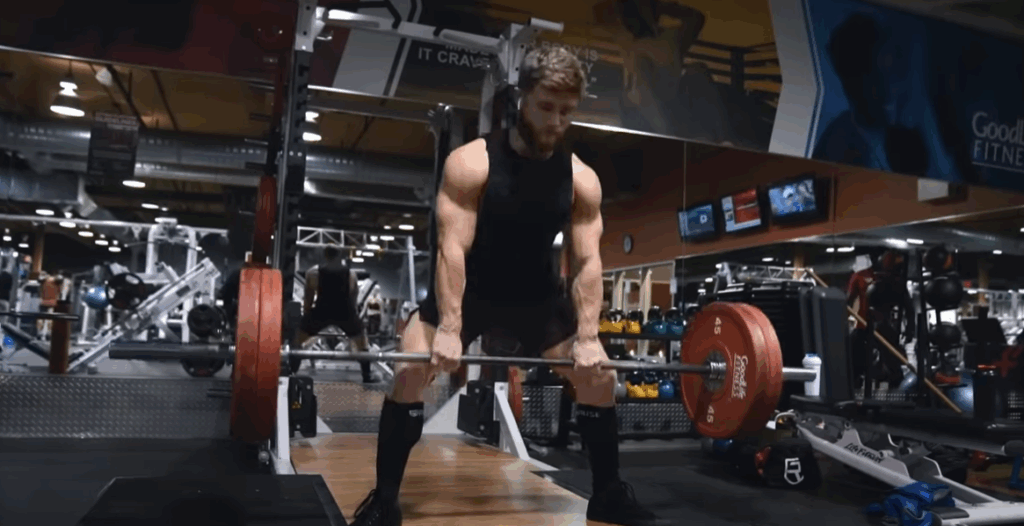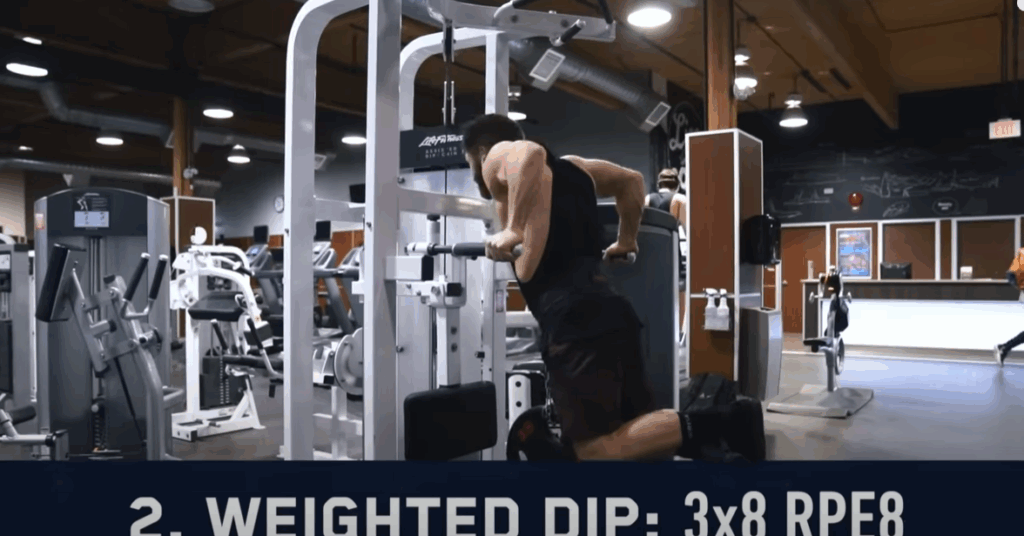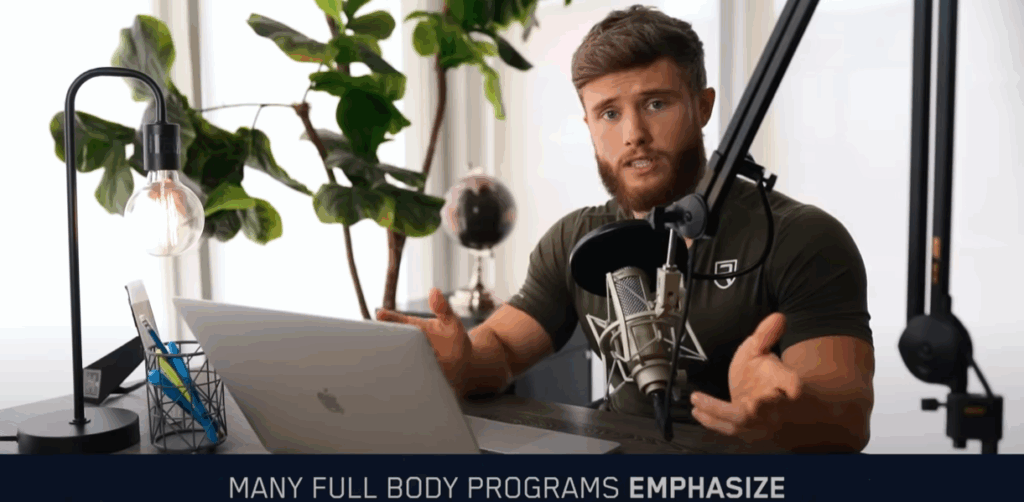Leg-Dominant Full-Body Workout: Optimizing Strength and Hypertrophy Through Science-Based Training
If you’re following a full-body training program and looking to emphasize leg development without sacrificing overall balance, today’s session is for you. This workout forms the fourth session in a high-frequency full-body routine, with a targeted focus on lower-body volume while still incorporating upper-body movements for symmetry and functional performance.
Before diving in, make sure you’re familiar with the fundamentals of full-body training at a high frequency. If not, reviewing a structured breakdown on how and why this training model works will give you better context for the program structure.

1. Reset Deadlifts – 3 Sets of 5 Reps at 75% of 1RM
The workout starts with a strength-building staple: the deadlift. In this case, we’re applying a “reset” variation where each rep begins from a dead stop. Unlike the commonly used “touch and go” reps that utilize rebound momentum, this method requires you to pause fully between reps, eliminating stretch reflex and forcing complete power generation from the floor.
Some lifters define “reset” deadlifts as releasing the bar completely between each rep, standing up, and re-engaging their setup. Others keep their grip but allow the plates to settle on the floor momentarily. Both techniques improve setup consistency and strength off the floor—particularly useful for lifters who struggle with their initial pull mechanics.
While deadlifts often get labeled as more functional than hypertrophic, they remain a powerhouse movement for total posterior chain development—hamstrings, glutes, spinal erectors, and traps all work in unison. On a leg-emphasis day, this variation builds foundational strength and reinforces proper lifting technique.
Sumo vs Conventional: Choosing the Right Deadlift Stance
Although the difference in muscle activation between sumo and conventional deadlifts is subtle, sumo does shift more load toward the quadriceps and away from the lower back, which is ideal for high-frequency training splits where fatigue management matters.
Statistical analyses from competitive powerlifting events suggest lighter lifters often favor sumo, while heavier lifters gravitate toward conventional. This could be due to limb length ratios and body mechanics. Rather than guessing, try both variations and assess which feels more natural and produces stronger performance.
For extra efficiency, use cues to engage the lats by imagining you’re pulling the bar toward your shins. This cue not only tightens the upper body but shortens the bar path and reduces torque demand on the hips and lower spine.
2. Weighted Dips – 3 Sets of 8 Reps
Dips can be controversial due to potential shoulder strain, but when executed correctly, they’re one of the best compound chest and triceps exercises. To protect the shoulders, keep your scapula retracted and avoid dipping too deep—an elbow angle near 90 degrees is typically enough to stimulate muscle growth without risking joint integrity.
Contrary to popular belief, dips don’t just hit the lower chest. Electromyography (EMG) data has shown that they activate upper chest fibers more than even incline presses in some setups. You can enhance chest involvement by leaning slightly forward and focusing on driving your hands down, similar to a decline press.

3. Leg Extensions – 3 Sets of 20 Reps
After hitting a heavy compound lift, isolating the quads helps bring out the detail and develop a better mind-muscle connection. High-rep leg extensions emphasize metabolic stress and muscle tension—two key drivers of hypertrophy.
Instead of simply kicking the weight, focus on contracting your quads before initiating the rep. Try to relax your hamstrings and calves so the tension remains in your quads alone. During the lowering phase, maintain quad engagement to control the descent. This refined execution will result in a deeper burn and greater muscular fatigue even with moderate loads.
Spacing leg isolation movements between upper-body sets—rather than grouping all leg exercises together—improves recovery during the session and ensures better performance.
4. Single-Arm Lat Pulldown – 3 Sets of 12 Reps Per Side
To diversify your pulling movements and minimize joint stress from repetitive barbell lifts, incorporate unilateral lat work. By training each side individually, you reduce muscular imbalances and develop a stronger connection with the weaker side.
When performing these, pull the elbow both down and in, combining shoulder adduction and extension. This fully activates the lats and mimics their complete anatomical function more accurately than standard bilateral pulldowns.
Unilateral exercises also allow you to spot-check postural differences, strength asymmetries, and technique flaws that often go unnoticed during barbell rows or pull-ups.
5. Giant Set Finisher – 3 Rounds of 15 Reps Each
The workout concludes with a metabolic conditioning-style finisher to target upper-body muscles that may receive less attention in compound lifts. Perform the following exercises back-to-back as a tri-set:

• Face Pulls (Rear Delt Focus)
Use a rope attachment at eye level. Rather than rowing straight back, externally rotate your shoulders as you pull, as if performing a rear double biceps pose. This targets the rear delts and external rotators—often neglected but crucial for balanced shoulder health.
• Overhead Cable Triceps Extension
Using the rope allows for a deeper stretch and more natural elbow movement. Focus on squeezing your triceps at the top of each rep, and don’t be afraid to allow your arms to travel slightly behind your head to extend the range of motion safely.
• Egyptian Cable Lateral Raise
Set the pulley low and pull laterally across your body. Unlike dumbbell raises where tension is lost at the bottom, cables provide consistent resistance throughout. This method stretches the lateral delts fully while keeping them under constant tension—perfect for capped shoulder development.
Final Thoughts
This leg-focused full-body session strikes a careful balance between compound lifts, isolation work, and unilateral exercises. By blending strength-focused movements with hypertrophy-driven volume and finishing with metabolic fatigue, you’ll ensure a comprehensive training stimulus across all major muscle groups—with an emphasis on the lower body.
If you’re serious about maximizing results with full-body training, structuring your weekly volume intelligently is key. Be sure to monitor recovery, rotate movement patterns when needed, and keep technique as the top priority.
Looking to take this training strategy to the next level? A full 10-week periodized high-frequency program that incorporates progressive overload, volume distribution, and deloading protocols can accelerate both muscle growth and strength gains while keeping your joints healthy and progress sustainable.



